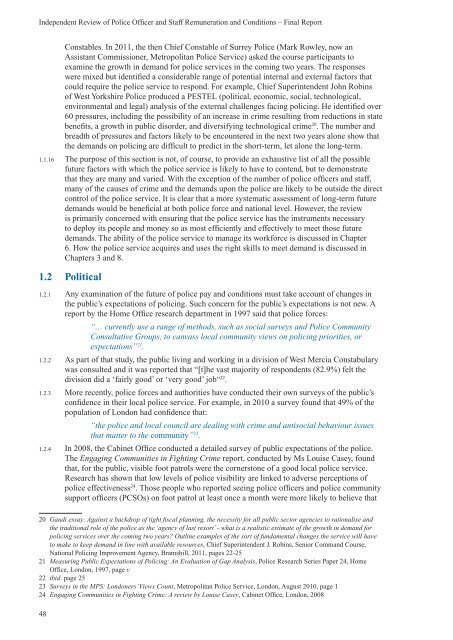Independent Review of Police Officer and Staff Remuneration and ...
Independent Review of Police Officer and Staff Remuneration and ...
Independent Review of Police Officer and Staff Remuneration and ...
You also want an ePaper? Increase the reach of your titles
YUMPU automatically turns print PDFs into web optimized ePapers that Google loves.
<strong>Independent</strong> <strong>Review</strong> <strong>of</strong> <strong>Police</strong> <strong>Officer</strong> <strong>and</strong> <strong>Staff</strong> <strong>Remuneration</strong> <strong>and</strong> Conditions – Final Report<br />
Constables. In 2011, the then Chief Constable <strong>of</strong> Surrey <strong>Police</strong> (Mark Rowley, now an<br />
Assistant Commissioner, Metropolitan <strong>Police</strong> Service) asked the course participants to<br />
examine the growth in dem<strong>and</strong> for police services in the coming two years. The responses<br />
were mixed but identified a considerable range <strong>of</strong> potential internal <strong>and</strong> external factors that<br />
could require the police service to respond. For example, Chief Superintendent John Robins<br />
<strong>of</strong> West Yorkshire <strong>Police</strong> produced a PESTEL (political, economic, social, technological,<br />
environmental <strong>and</strong> legal) analysis <strong>of</strong> the external challenges facing policing. He identified over<br />
60 pressures, including the possibility <strong>of</strong> an increase in crime resulting from reductions in state<br />
benefits, a growth in public disorder, <strong>and</strong> diversifying technological crime20 . The number <strong>and</strong><br />
breadth <strong>of</strong> pressures <strong>and</strong> factors likely to be encountered in the next two years alone show that<br />
the dem<strong>and</strong>s on policing are difficult to predict in the short-term, let alone the long-term.<br />
1.1.16 The purpose <strong>of</strong> this section is not, <strong>of</strong> course, to provide an exhaustive list <strong>of</strong> all the possible<br />
future factors with which the police service is likely to have to contend, but to demonstrate<br />
that they are many <strong>and</strong> varied. With the exception <strong>of</strong> the number <strong>of</strong> police <strong>of</strong>ficers <strong>and</strong> staff,<br />
many <strong>of</strong> the causes <strong>of</strong> crime <strong>and</strong> the dem<strong>and</strong>s upon the police are likely to be outside the direct<br />
control <strong>of</strong> the police service. It is clear that a more systematic assessment <strong>of</strong> long-term future<br />
dem<strong>and</strong>s would be beneficial at both police force <strong>and</strong> national level. However, the review<br />
is primarily concerned with ensuring that the police service has the instruments necessary<br />
to deploy its people <strong>and</strong> money so as most efficiently <strong>and</strong> effectively to meet those future<br />
dem<strong>and</strong>s. The ability <strong>of</strong> the police service to manage its workforce is discussed in Chapter<br />
6. How the police service acquires <strong>and</strong> uses the right skills to meet dem<strong>and</strong> is discussed in<br />
Chapters 3 <strong>and</strong> 8.<br />
1.2 Political<br />
1.2.1 Any examination <strong>of</strong> the future <strong>of</strong> police pay <strong>and</strong> conditions must take account <strong>of</strong> changes in<br />
the public’s expectations <strong>of</strong> policing. Such concern for the public’s expectations is not new. A<br />
report by the Home Office research department in 1997 said that police forces:<br />
“… currently use a range <strong>of</strong> methods, such as social surveys <strong>and</strong> <strong>Police</strong> Community<br />
Consultative Groups, to canvass local community views on policing priorities, or<br />
expectations” 21 .<br />
1.2.2 As part <strong>of</strong> that study, the public living <strong>and</strong> working in a division <strong>of</strong> West Mercia Constabulary<br />
was consulted <strong>and</strong> it was reported that “[t]he vast majority <strong>of</strong> respondents (82.9%) felt the<br />
division did a ‘fairly good’ or ‘very good’ job” 22 .<br />
1.2.3 More recently, police forces <strong>and</strong> authorities have conducted their own surveys <strong>of</strong> the public’s<br />
confidence in their local police service. For example, in 2010 a survey found that 49% <strong>of</strong> the<br />
population <strong>of</strong> London had confidence that:<br />
“the police <strong>and</strong> local council are dealing with crime <strong>and</strong> antisocial behaviour issues<br />
that matter to the community” 23 .<br />
1.2.4 In 2008, the Cabinet Office conducted a detailed survey <strong>of</strong> public expectations <strong>of</strong> the police.<br />
The Engaging Communities in Fighting Crime report, conducted by Ms Louise Casey, found<br />
that, for the public, visible foot patrols were the cornerstone <strong>of</strong> a good local police service.<br />
Research has shown that low levels <strong>of</strong> police visibility are linked to adverse perceptions <strong>of</strong><br />
police effectiveness24 . Those people who reported seeing police <strong>of</strong>ficers <strong>and</strong> police community<br />
support <strong>of</strong>ficers (PCSOs) on foot patrol at least once a month were more likely to believe that<br />
20 Gaudi essay: Against a backdrop <strong>of</strong> tight fiscal planning, the necessity for all public sector agencies to rationalise <strong>and</strong><br />
the traditional role <strong>of</strong> the police as the ‘agency <strong>of</strong> last resort’ - what is a realistic estimate <strong>of</strong> the growth in dem<strong>and</strong> for<br />
policing services over the coming two years? Outline examples <strong>of</strong> the sort <strong>of</strong> fundamental changes the service will have<br />
to make to keep dem<strong>and</strong> in line with available resources, Chief Superintendent J. Robins, Senior Comm<strong>and</strong> Course,<br />
National Policing Improvement Agency, Bramshill, 2011, pages 22-25<br />
21 Measuring Public Expectations <strong>of</strong> Policing: An Evaluation <strong>of</strong> Gap Analysis, <strong>Police</strong> Research Series Paper 24, Home<br />
Office, London, 1997, page v<br />
22 ibid. page 25<br />
23 Surveys in the MPS: Londoners’ Views Count, Metropolitan <strong>Police</strong> Service, London, August 2010, page 1<br />
24 Engaging Communities in Fighting Crime: A review by Louise Casey, Cabinet Office, London, 2008<br />
48

















